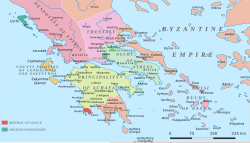This article needs additional citations for verification .(December 2022) |
| Lordship of Salona | |||||||||
|---|---|---|---|---|---|---|---|---|---|
| Vassal lordship (after 1318 County) of the Duchy of Athens | |||||||||
| 1205–1210 1212–1394 1404–1410 | |||||||||
 The Byzantine Empire and the Latin states in southern Greece c. 1278 | |||||||||
| Capital | Salona (La Sole) | ||||||||
| Government | |||||||||
| • Type | Feudal principality | ||||||||
| Lord (after 1318, Count) | |||||||||
• 1205–1210 | Thomas I d'Autremencourt (first Lord) | ||||||||
• 1318–1338 | Alfonso Fadrique (first Count) | ||||||||
| Historical era | Middle Ages | ||||||||
• Frankish conquest | 1205 | ||||||||
• Ottoman conquest | 1410 | ||||||||
| |||||||||
| Today part of | Greece | ||||||||
The Lordship of Salona, after 1318 the County of Salona, was a Crusader state established after the Fourth Crusade (1204) in Central Greece, around the town of Salona (modern Amfissa, known in French as La Sole and Italian as La Sola).




